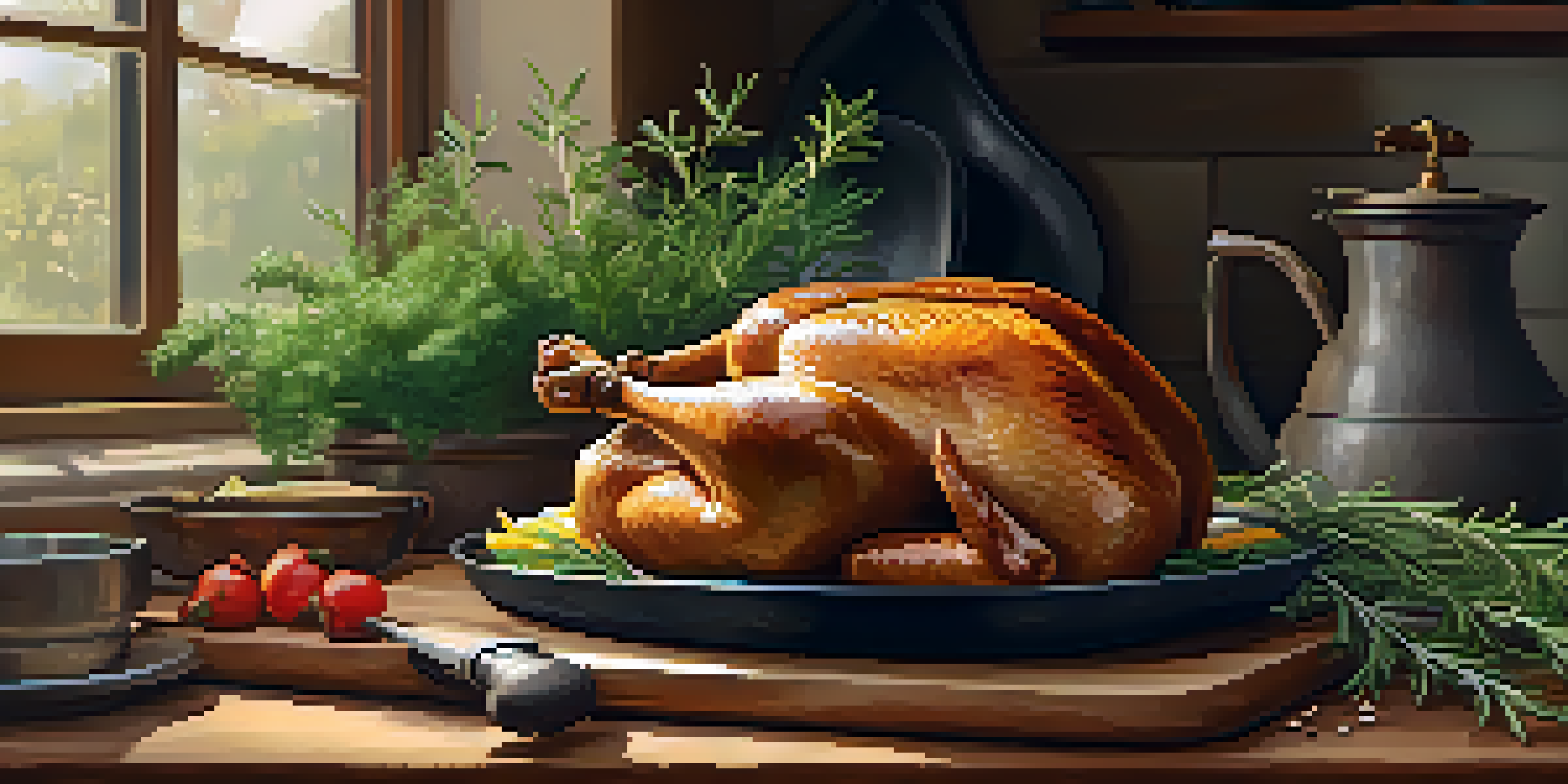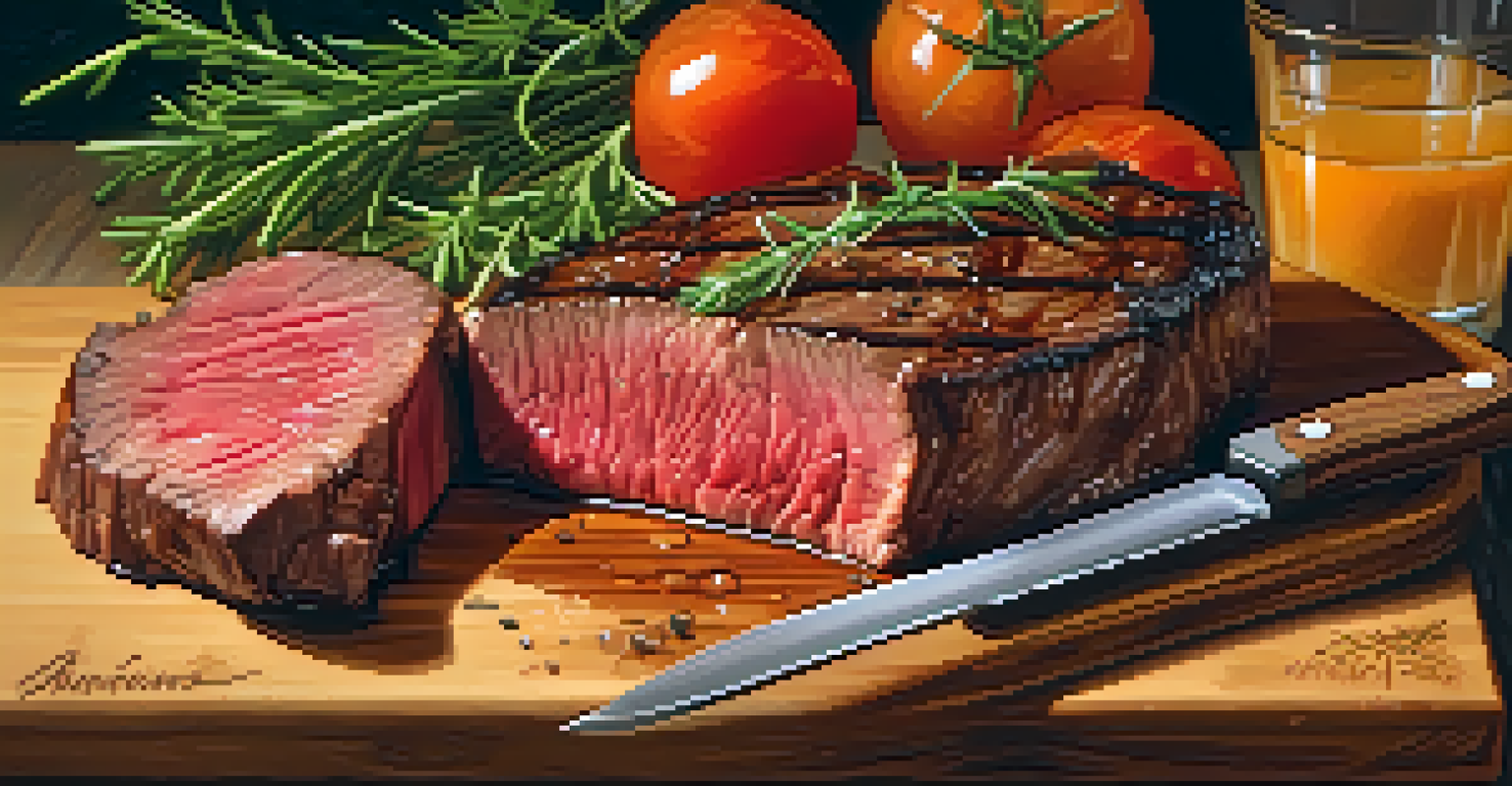The Techniques of Historical Roasting: A Culinary Guide

Understanding the Art of Historical Roasting
Historical roasting is a culinary technique that dates back centuries, where meats and vegetables are cooked over an open flame or in an oven. This method not only imparts rich flavors but also creates a delightful crust that seals in juices. Understanding the nuances of this cooking style can elevate your home cooking, making it not just a meal but an experience.
Cooking is like love. It should be entered into with abandon or not at all.
Different cultures have their own roasting traditions, from the spit-roasting of medieval Europe to the tandoors of India. Each method brings its unique flair and flavor profiles, showcasing the versatility of roasting. By exploring these methods, we can appreciate the depth of culinary history while incorporating these techniques into our modern kitchens.
For anyone looking to dive into roasting, knowing its historical roots can inspire creativity. It’s an invitation to experiment with flavors and techniques passed down through generations, allowing you to connect with the past while crafting delicious meals today.
Essential Tools for Successful Roasting
To roast effectively, having the right tools is key. Basic equipment includes a sturdy roasting pan, a reliable meat thermometer, and, if possible, a rotisserie for even cooking. These tools not only make the process easier but also help achieve that perfect golden-brown crust that everyone loves.

If you’re aiming for a more traditional approach, consider investing in cast iron cookware or a Dutch oven. These materials retain heat exceptionally well, ensuring your roasts cook evenly and stay juicy. Plus, they add a rustic charm to your kitchen and can often go from stovetop to oven seamlessly.
Roasting Traditions Across Cultures
Different cultures have unique roasting methods that enhance flavors and connect us to culinary history.
Finally, don't overlook the importance of a good carving knife. A sharp knife makes it easier to slice through the meat without tearing, allowing you to present your roast beautifully. The right tools not only enhance your roasting experience but also make it more enjoyable and rewarding.
Choosing the Right Ingredients for Roasting
The foundation of any great roast is high-quality ingredients. When selecting meats, look for cuts that are well-marbled, as the fat will render during cooking, keeping the meat moist. Fresh vegetables and herbs also play a crucial role, adding depth and flavor to your dish.
Food is our common ground, a universal experience.
In historical contexts, seasonal and local ingredients were often used. This practice not only ensures freshness but also connects your meal to your environment. Using herbs like rosemary or thyme can enhance flavor profiles, while vegetables like root crops offer great roasting potential.
Moreover, don't be afraid to experiment with marinades or rubs. These can add layers of flavor, transforming a simple roast into a memorable feast. By choosing the right ingredients, you're not just cooking; you're creating a dish that tells a story.
Mastering Temperature and Timing in Roasting
Temperature control is vital for roasting, as it can make or break your dish. Generally, higher temperatures (around 400°F to 450°F) are ideal for roasting vegetables, while meats may start high and be finished at lower temperatures to avoid drying out. Understanding the science behind heat will help you achieve that perfect roast every time.
Using a meat thermometer is an invaluable way to ensure your meat is cooked to perfection. Different cuts have varying ideal internal temperatures, so familiarizing yourself with these can help prevent overcooking. For example, a medium-rare steak should be around 130°F to 135°F for optimal flavor and tenderness.
Essential Tools for Roasting Success
Having the right tools, like a sturdy roasting pan and a meat thermometer, is crucial for achieving a perfect roast.
Timing is equally important. While many recipes provide guidelines, factors like the size of your roast and the type of oven can affect cooking time. It's always best to keep an eye on your roast, checking periodically and adjusting as needed to achieve that beautifully cooked dish.
Flavoring Techniques: Herbs, Spices, and More
Flavoring your roast can be as simple or as complex as you desire, starting with herbs and spices. Fresh herbs like parsley, rosemary, and thyme can be used both inside and out of the roast for a burst of flavor. Spices, such as paprika or cumin, can provide an additional layer of depth, making your dish truly unique.
Incorporating marinades is another fantastic method to infuse flavor. A marinade made with oil, vinegar, and herbs can tenderize the meat while adding seasoning. Letting your roast marinate overnight can yield impressive results, as the flavors have more time to penetrate the meat.
Don’t forget about the importance of salt. It enhances the natural flavors of your ingredients and makes everything taste better. Whether you choose to brine your meat or simply season it before roasting, salt is an essential component of a delicious roast.
The Role of Resting in the Roasting Process
Once your roast is cooked, it’s tempting to slice right in, but resting is a crucial step that many overlook. Allowing your meat to rest for 10 to 20 minutes helps the juices redistribute, making for a juicier and more flavorful result. Think of it as giving your roast a moment to relax after its time in the heat.
During resting, cover your roast loosely with foil to keep it warm. This will also help retain moisture without steaming the crust, which is essential for texture. It’s a small step that can make a significant difference in the final presentation and taste of your dish.
Importance of Resting Your Roast
Allowing your roast to rest after cooking helps retain juices and enhances the overall flavor and presentation.
Resting is not just for meats; it applies to roasted vegetables, too. Letting them sit allows the flavors to meld and intensify, enhancing your overall meal. So, practice patience—it will pay off in flavor and satisfaction.
Serving and Pairing Your Roasted Creations
Once your roast has rested and is ready to serve, presentation is key. Arrange the sliced meat on a platter, garnished with fresh herbs or colorful roasted vegetables. A visually appealing dish sets the stage for a memorable meal, inviting everyone to dig in.
Pairing your roast with the right sides can elevate the entire dining experience. Classic accompaniments include mashed potatoes, roasted seasonal vegetables, or a fresh salad. Additionally, consider what wines or beverages will complement the flavors of your dish, enhancing the overall meal.

Finally, don’t forget about leftovers! Roasted meats can be transformed into sandwiches, salads, or soups, ensuring no delicious morsel goes to waste. Embracing the full life cycle of your roast reflects a sustainable approach to cooking, making it not just delicious, but responsible.